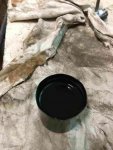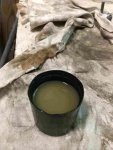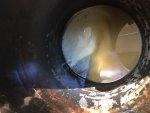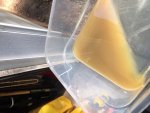I have a Kubota L48 TLB. The dipper stick cylinder on the backhoe began to leak pretty badly about a month ago and today I removed it to take it to the dealer for a rebuild. I disconnected the 2 hydraulic hoses from the cylinder, knocked out the 2 pins attaching the cylinder to the backhoe dipper stick and removed the cylinder. I laid it horizontally and drained the fluid that was in the cylinder into a bucket. In the two attached photos, the first one is new fluid directly from a 2.5 gallon jug of Kubota hydraulic fluid, and the second photo is the fluid that came out of the cylinder that I'm having rebuilt. Based on other posts I've read, the milky fluid that was in the cylinder means that water was contaminating the fluid. But, I have been checking my fluid every time I use the machine (and I have been using it more than usual over the last month) and whenever I check the fluid, including today, it looks clear. Also, I had complete fluid change done at the dealer, 90 hours ago.
Today, I didn't have a good way to pull some fluid directly out of the hydraulic fluid reservoir. I could only pull out the dipstick and look at the fluid, but I did that several times, one right after the other and was able to get enough hydraulic fluid on my finger so it would drip. That fluid was definitely clear. I then took the dipstick and dipped it in the bucket with the drained, milky fluid and used the dipstick to put the same amount of fluid on my finger, as before, and that fluid definitely looked milky as it dripped down my finger. Now.....the machine is stored outside with a cover over the driver's compartment. When stored, the dipper stick cylinder faces up, so I'm thinking that with the bad seal that was leaking.....could rain be entering the cylinder at the piston seal? We have had some heavy rain over the past month. Also, I have used the backhoe for only about 10 minutes over the past month, and that was 1 week ago. Otherwise, that cylinder has been inactive. And, the day before I used the backhoe for that 10 minutes, I pressure washed the machine, and definitely squirted 2000 psi water around the piston ends of the hydraulic cylinders.
QUESTIONS:
1. Is it a mistake to use a pressure washer around the seals of the hydraulic cylinders?
2. Is it possible for the hydraulic fluid in the cylinder to be contaminated, but not the rest of the fluid in the machine?
3. With what I've described in this post, do I need to suck it up and perform a complete filters and fluid change?
Thanks!
Today, I didn't have a good way to pull some fluid directly out of the hydraulic fluid reservoir. I could only pull out the dipstick and look at the fluid, but I did that several times, one right after the other and was able to get enough hydraulic fluid on my finger so it would drip. That fluid was definitely clear. I then took the dipstick and dipped it in the bucket with the drained, milky fluid and used the dipstick to put the same amount of fluid on my finger, as before, and that fluid definitely looked milky as it dripped down my finger. Now.....the machine is stored outside with a cover over the driver's compartment. When stored, the dipper stick cylinder faces up, so I'm thinking that with the bad seal that was leaking.....could rain be entering the cylinder at the piston seal? We have had some heavy rain over the past month. Also, I have used the backhoe for only about 10 minutes over the past month, and that was 1 week ago. Otherwise, that cylinder has been inactive. And, the day before I used the backhoe for that 10 minutes, I pressure washed the machine, and definitely squirted 2000 psi water around the piston ends of the hydraulic cylinders.
QUESTIONS:
1. Is it a mistake to use a pressure washer around the seals of the hydraulic cylinders?
2. Is it possible for the hydraulic fluid in the cylinder to be contaminated, but not the rest of the fluid in the machine?
3. With what I've described in this post, do I need to suck it up and perform a complete filters and fluid change?
Thanks!
Attachments
-
74.2 KB Views: 279
-
68.2 KB Views: 478
Last edited:





